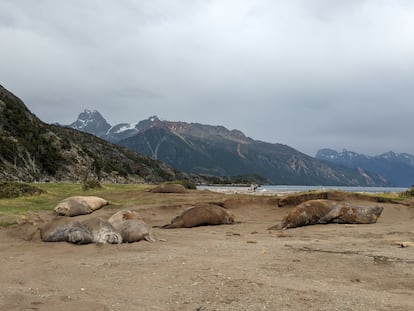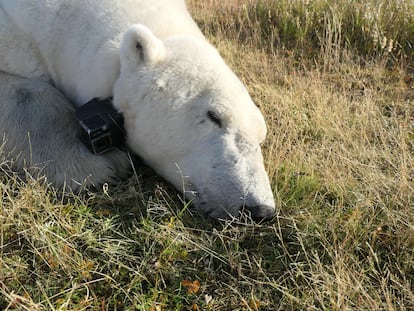Polar ice melt caused by climate change is slowing the Earth’s rotation
The alteration could affect timekeeping and, ultimately, counteract today’s need to add a leap second to the year every so often

The melting of polar ice caused by climate change is affecting the rotation of the Earth. The redistribution of the now liquid frozen masses could be slowing the planet’s spin on its axis, as if it were a skater extending his or her arms. The phenomenon, which joins others affecting the Earth’s movement, such as the slowdown in the core, will have an impact on timekeeping, increasing the lack of synchrony between universal and atomic time.
Mathematics says that a day has 86,400 seconds, but this is wrong. Days on Earth do not have that exact duration because the Earth’s rotation is not regular. Among the factors that intervene in this irregularity are the friction of the tides, or the fact that the planet is not a solid sphere but is made up of different solid or liquid masses, both on its surface and inside. Despite such irregularity, the astronomical second was accepted as the basis of universal time (UT1). But in 1967, the internationally accepted definition of the second changed. The measurement of time, which had been linked to the Earth’s rotation, became determined by the first atomic clocks, the basis of Coordinated Universal Time (UTC), the primary time standard. But its precision is such that the lack of synchrony between universal time and UTC had to be recovered by introducing a leap second every so often. Now a new problem is emerging, the need to subtract a second instead of adding it, a problem that has to do with climate-related melting of polar ice.
The connection has been established by Duncan Agnew, a researcher at the University of California in San Diego. For years, Agnew has studied the so-called postglacial rebound. For more than 100,000 years, much of the Northern Hemisphere was covered in ice. But it was not a thin layer. As in Antarctica today, it was a layer two or three kilometers thick. With the end of the last ice age, about 11,000 years ago, the Earth’s crust, freed from so much weight, uplifted, thereby disrupting the rotation of the planet. This caused the days to become longer. To this isostatic adjustment, Agnew now adds the accelerated melting that is occurring in continental frozen masses, such as those in Greenland, due to climate change.
“The meltwater goes to the ocean and raises sea level. This is equivalent to a transfer of mass from the poles to the equator, which slows down the speed of the Earth’s rotation,” Agnew says in a statement. As detailed in a work published in the scientific journal Nature, until 1990, measurements of the planet’s gravity showed that it was spinning faster. But their measurements based on satellite records find that this trend has reversed and caused the Earth to spin more slowly.
The researcher at the High Energy Physics Laboratory of the Federal Polytechnic School of Lausanne (Switzerland) María Vieites, who did not participate in this research, compares what Agnew observed with figure skating: “The ice that concentrates at the poles works as the skater’s arms. At the top, they are very close to the axis and that makes turning easier, but when you lower them and extend them, it slows down.” Like the extremities, meltwater spreads across the planet in a redistribution of mass that affects rotation.
Agnew also introduces another factor into his equation. In addition to tidal friction and melting ice, the irregularity of the Earth’s rotation also involves the behavior of the planet’s core, which is also liquid. In January 2023, it was found that the Earth’s core was slowing down, even turning in the opposite direction to the rest of the planet. The slowdown is going to affect the weather. “Extrapolation of the causes of the change in the speed of the Earth’s rotation suggests that, by 2029, the timescale generally used will require, according to current rules, that a minute lasts only 59 seconds,” says the American geophysicist. “This has never happened before and poses a huge challenge in ensuring that all parts of the global timing infrastructure show the same time,” he adds.
Currently, UCT is calculated with some 450 atomic clocks spread throughout the planet. Its signal is broadcast in real time by about 80 time laboratories. They are the temporal basis of the internet, financial systems, satellites and more. Since 1972, irregularities in the movement of the Earth have forced 27 leap seconds to be added, at irregular intervals and with a maximum of only six months in advance each time. What this work shows is that now they will have to face the opposite problem, subtracting a second.
“The negative leap second has never been implemented,” notes Commander Héctor Esteban Pinillos, head of the Time Section of the Spanish Royal Institute and Observatory of the Navy (ROA), the body in charge of setting the official time in Spain. “We don’t know how it will affect the different systems, especially the older ones,” he adds. The fact that leap seconds have always been positive could have led to “the programmers not having taken the negative second into account in the code,” he adds. But the captain believes that, in due course, “the impact will be economic, but the internet will not go down.”
However, the problem will resurface in a few decades. Since the 1970s, leap seconds have been added to the last minute of the year or the first minute of the next, although there were large companies like Amazon or Google that distributed them over the previous or following 24 hours. But the International Bureau of Weights and Measures (BIPM), world coordinator of metrology (the scientific study of measurement), is considering eliminating this adjustment method. The logic is explained by María Dolores del Campo, director of the division of mechanical magnitudes and engineering of the Spanish Metrology Center: “To make the UTC match the timescale calculated through the rotation of the earth (UT1) a second was added every time the difference between the two approached 0.9 s. If the difference were negative, due to the change in the speed of rotation of the Earth, a second would have to be removed.”
But it will not be necessary because, as Del Campo says, “at the 2022 General Conference on Weights and Measures it was approved to stop introducing leap seconds (neither positive nor negative) until the year 2035, since it poses a problem in all systems of communication and positioning to have to introduce this correction.” What will be done from that year onwards has yet to be decided, but Del Campo points out that the idea most likely to become the norm is “not to reintroduce leap seconds until the difference between UTC and UT1 is greater than, for example, one minute; which may lead to not having to introduce them until perhaps more than a century from now.”
Sign up for our weekly newsletter to get more English-language news coverage from EL PAÍS USA Edition
Tu suscripción se está usando en otro dispositivo
¿Quieres añadir otro usuario a tu suscripción?
Si continúas leyendo en este dispositivo, no se podrá leer en el otro.
FlechaTu suscripción se está usando en otro dispositivo y solo puedes acceder a EL PAÍS desde un dispositivo a la vez.
Si quieres compartir tu cuenta, cambia tu suscripción a la modalidad Premium, así podrás añadir otro usuario. Cada uno accederá con su propia cuenta de email, lo que os permitirá personalizar vuestra experiencia en EL PAÍS.
¿Tienes una suscripción de empresa? Accede aquí para contratar más cuentas.
En el caso de no saber quién está usando tu cuenta, te recomendamos cambiar tu contraseña aquí.
Si decides continuar compartiendo tu cuenta, este mensaje se mostrará en tu dispositivo y en el de la otra persona que está usando tu cuenta de forma indefinida, afectando a tu experiencia de lectura. Puedes consultar aquí los términos y condiciones de la suscripción digital.
More information
Últimas noticias
Most viewed
- Reinhard Genzel, Nobel laureate in physics: ‘One-minute videos will never give you the truth’
- Pablo Escobar’s hippos: A serious environmental problem, 40 years on
- Charles Dubouloz, mountaineering star, retires at 36 with a farewell tour inspired by Walter Bonatti
- Why we lost the habit of sleeping in two segments and how that changed our sense of time
- The Florida Keys tourist paradise is besieged by immigration agents: ‘We’ve never seen anything like this’











































